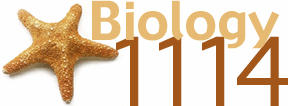
Course Schedule - Spring 2002
|
Date
|
Week
|
Scenario
|
Lab Topic
|
| 14 Jan |
1
|
Psychics and Scientists: A series of short scenarios will center on measurement of psychic phenomena, a faculty research question, a breath holding experiment, analysis of class score data, to introduce the concepts of hypotheses testing, scientific predictions, experimental design, and what is a theory. | Form Groups, Learn lab rules |
| 21 Jan |
M
|
Martin Luther King Holiday: No Class | |
| 21 Jan |
2
|
Surviving Fire and Ice: The scenario focuses on surviving in desert and tundra and adaptations for thermoregulation and water retention. | Larger Quattro variegatus are eaten more often because they are easier to see |
| 25 Jan |
F
|
Last day to drop with no grade | |
| 28 Jan |
3
|
Out of the Rain Forest: An aboriginal fishing expedition in the rain forest is explored in terms of the action of a toxin produced by plants. Pesticides, coevolution, cell membrane function and cell respiration will be discussed. | Body shapes influence the rate of heat gain or loss in a predictable way. |
| 4 Feb |
4
|
Out of the Rain Forest continued. | How is metabolic rate influenced by ambient temperature? |
| 11 Feb |
M
|
EXAM 1 at 5:30 pm in CLB 313 | |
| 11 Feb |
5
|
Chemical Defenses: A Nigerian child eats a poisonous bean, which requires extraordinary treatment by the local physician, framing investigation of cell membrane structure, secretion, intercellular communication, and neurons. | How do various factors influence the passage of materials through a membrane? |
| 18 Feb |
6
|
Marooned in the Galapagos: This trip raises questions about what makes a species or organism successful. Attention to the physical character of these desert islands and animals living there highlights natural selection in action. | How can cell structure be used to identify cell type, function, or location? |
| 25 Feb |
7
|
Rainbow Connection: A scuba diving botanist is sent by the Smithsonian to collect algae. Blood is spilled and the biological uses of colored light, including photosynthesis, are explored. | How does seed/nut diversity and abundance influence survival of birds with different beak types? |
| 4 Mar |
8
|
Rainbow Connection continued. | How does the color of light influence plant growth? |
| 11 Mar |
M
|
Exam 2 at 5:30 pm. in CLB 313 | |
| 11 Mar |
9
|
Emerging Diseases: On the Amazon we meet the Yanomami amidst a breaking TB epidemic, raising the roles of symbiosis, population dynamics and evolution in development of epidemics. | What factor(s) result in the greatest water loss from soil with plant cover? |
| 18 Mar |
|
Spring Break - No Class | |
| 25 Mar |
10
|
Emerging Diseases continued. | Does drug type or UV radiation influence evolution of antibiotic resistance? |
| 1 Apr |
11
|
Family Reunion: A family reunion opens the door to talk about cancer, DNA, protein synthesis, genetically determined diseases and biotechnology. | How can the genetic composition of bacteria be altered in the laboratory? |
| 8 Apr |
12
|
Family Reunion continued. | How can genetic material be identified in the laboratory? |
| 12 Apr |
F
|
Last day to drop
with automatic W
|
|
| 15 Apr |
M
|
Exam 3 at 5:30 pm in CLB 313 |
|
| 15 Apr |
13
|
Family Reunion continued. Hogs & Chickens: Statistics about concentrated animal feeding operations raise questions about nutrients in biogeochemical cycles, the effects of livestock and people on aquatic systems and the history of sewage. | Does sewage affect benthic and algal species diversity in streams? |
| 22 Apr |
14
|
Hogs & Chickens continued.Why We Care about Fat: our contemporary preoccupation with fat sets the scene for a discussion of fat metabolism, its genetic, nervous and hormonal control, and behavioral implications. | What leads to anoxia in polluted streams? |
| 29 Apr |
15
|
Why We Care about Fat continued. | On what basis do male or female guppies select mates? |
| 9 May |
Th
|
FINAL EXAM at 4:30 - 6:20pm in CLB 313 |